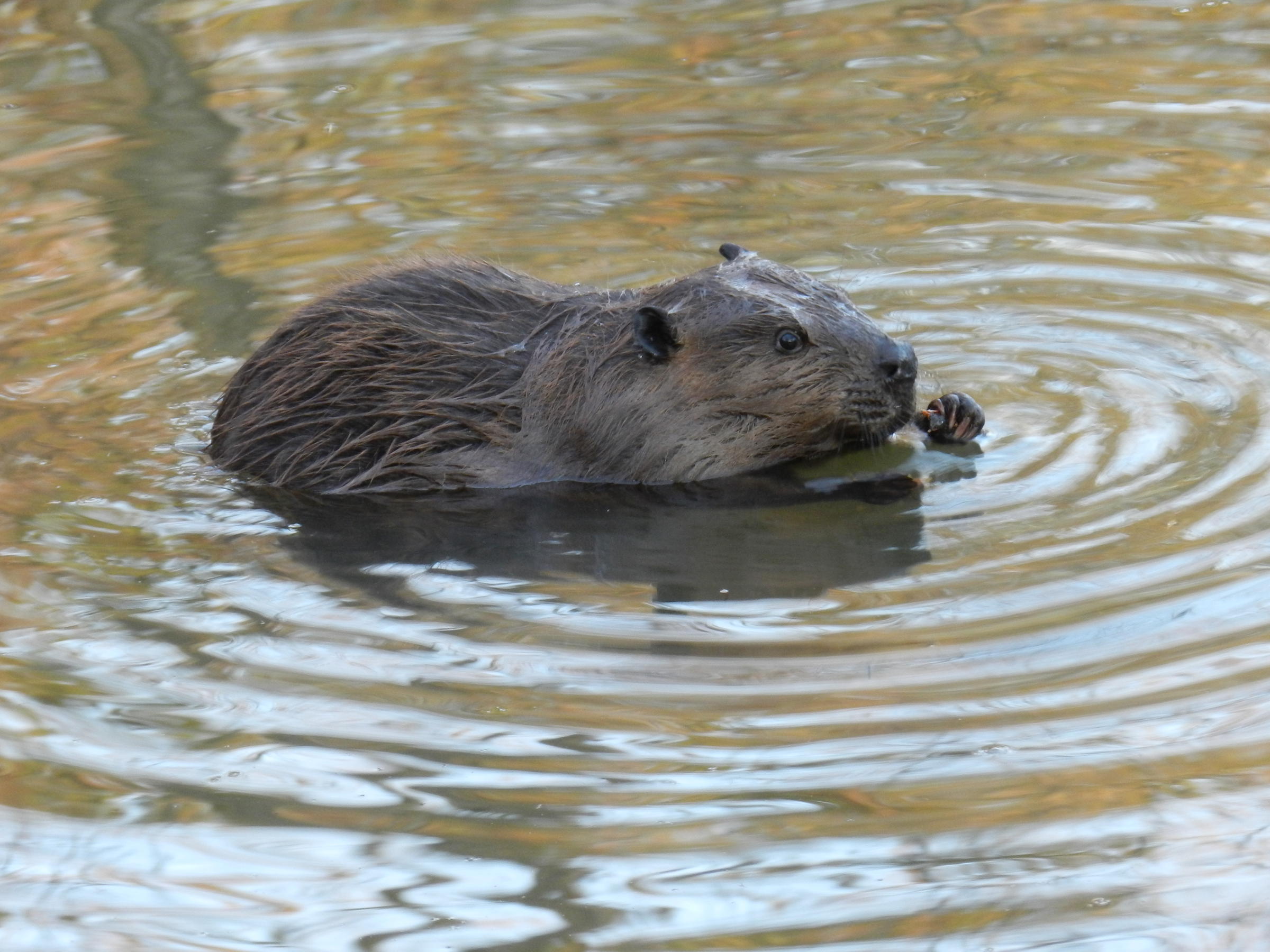Beavers In Buckhead? Yes, And They Help Restore Nature

One of the beavers that moved to the Blue Heron Nature Preserve in Buckhead. The two adults are nicknamed Belle and Beau.
MELANIE FURR / ATLANTA AUDUBON SOCIETY
About 15 years ago, a developer in Buckhead illegally drained a wetland. It had been a spot in the forest at the end of a cul-de-sac with little streams and water collecting in pools, where fish, frogs and birds lived.
The trench the developer dug rerouted the creek and drained the water out of the woods.
It was a violation of the federal Clean Water Act. The city of Atlanta ended up buying the property from the developer, and Emma Wetlands became part of the Blue Heron Nature Preserve. Now there are nature trails, and there has been work to remove weeds and add native plants. But restoring a wetland can cost hundreds of thousands of dollars, and that work never happened.
Or, at least, humans never did that work. But it turns out something else did: Beavers.
When you think of the wildlife in a city, beavers may not be the first animal that comes to mind, but they’re all over the place in Atlanta. And while the big, goofy-toothed swimming rodents can be a nuisance, it appears beavers may also help our environment.
Beaver Business
“The thing with beavers is they don’t like to walk. They are, you know, giant rodents with really short legs, and their preference is to always swim everywhere,” biology professor Elizabeth Sudduth tells a group of her students gathered in Emma Wetlands. She teaches at Georgia Gwinnett College, where she focuses on urban streams.
Beavers dig canals so they can swim instead of walk. And they build dams to create ponds, where they can swim, eat and make their homes.
The two adult beavers that moved to Emma Wetlands – nicknamed Belle and Beau – are basically civil engineers. They built their little water world in which to raise their kits. And what they’ve done is good for other things, too, because their ponds and canals are recreating the wetland.
“What I see is just the potential for all kinds of biological processes to be happening,” says Sudduth. “Cleaning the water. The wetland hosts a huge diversity of bird life that you wouldn’t see otherwise.”
Amphibians and fish thrive in Emma Wetlands, too.
What Sudduth is especially interested in is water quality. She’s studying if this creek is cleaner because of the beavers. She’s not quite finished with that work yet, but it has been done in other places.
“There’s more and more research coming out about that,” says Greg Lewallen, a Ph.D. student at the University of Saskatchewan, who studies beavers. He co-wrote a handbook on using beavers in river restoration for the U.S. Fish and Wildlife Service, and recently wrote a new chapter focusing on urban beavers.

Lewallen says beaver dams trap pollutants, and wetland plants help clean the water.
Out West, in states including Oregon, Idaho and Colorado, there have been some projects that actively try to attract beavers. That can save money on river restoration work that would otherwise require things like backhoes.
Beavers do it for free, with their teeth.
“They’re an incredible species,” says Lewallen. “We can relate to them in a lot of ways as humans in my opinion. They’re incredibly industrious and hard-working, and for a rodent species, they are extremely family-oriented.”
Lewallen says almost all major cities now have beaver populations. We don’t see them much because they’re nocturnal.
Beaver Drama
This all sounds good, but beavers can actually be a problem. They cut down trees. They cause flooding.
“It really just depends on the perspective,” says Linda May, environmental outreach coordinator with the Georgia Department of Natural Resources. “If they’re out in the woods doing their thing, then, of course, nobody seems to mind, but if it’s your yard or your field or your playground that’s being flooded by them, then you might have a different opinion.”
Beavers stuffing sticks into culverts and blocking them up under roads and highways seems to be a recurring issue, too.
Here in Georgia, they’re considered a nuisance animal; you can kill them any time, no permit needed. And they live all over the place: out in the forest; in the suburbs; in, well, North Buckhead just off Roswell Road.
This also speaks to a remarkable comeback the animals have made. They were almost extinct by the early-1900s because so many of them were trapped for their fur. (A campaign to reintroduce them included some cases of parachuting beaversinto remote mountain meadows.)
Anyway, now they’re back all over the country — including Atlanta.
“Basically any creek you go to in Atlanta probably has beavers,” says Sudduth. “Right here in the middle of Atlanta, we can have the sort of diversity that you’d otherwise have to go at least to the National Recreation Area or a state park to see.”
Sudduth says she plans to keep studying the beavers in Buckhead, and she hopes to expand her research to study more beavers in other streams in Atlanta.








